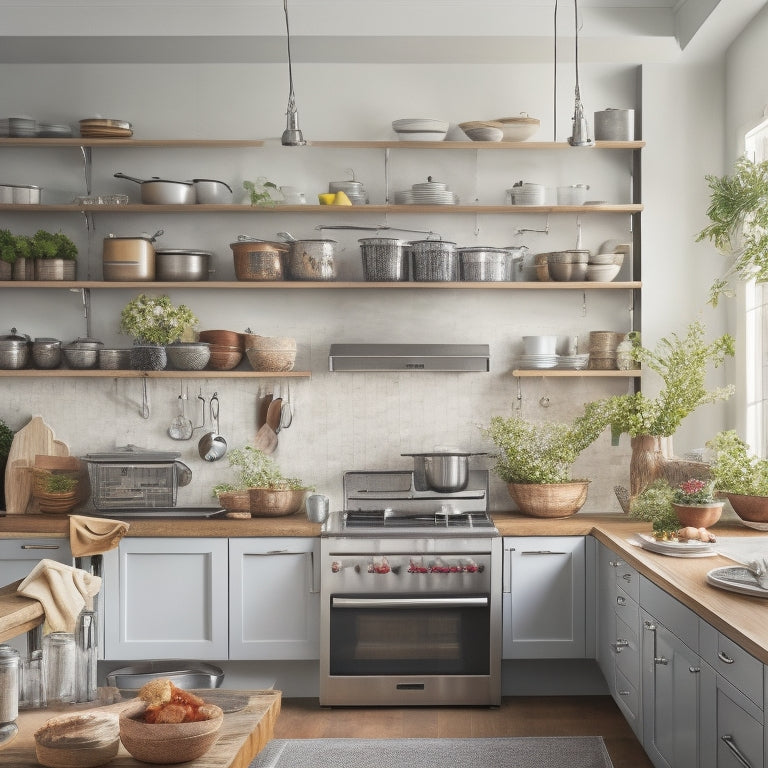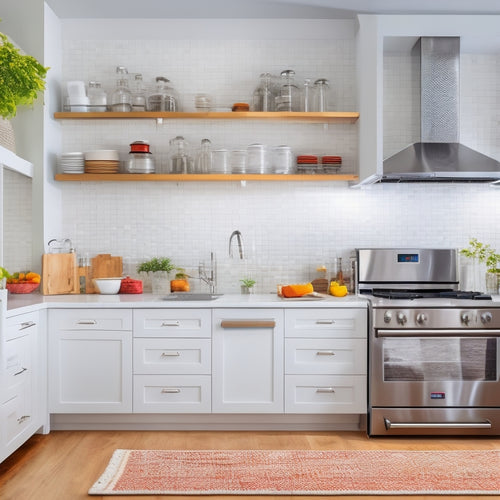
Organize Your Kitchen Elevate Your Cooking Skills
Share
You'll enhance your cooking skills by organizing your kitchen into a functional space that sparks creativity and streamlines meal prep. Start by decluttering and optimizing your layout for functionality, then implement effective storage solutions and vertical storage options. A well-organized pantry with customized shelving and clear, airtight containers will also boost your cooking confidence. By streamlining your kitchen workflow and maximizing storage space, you'll be able to manage your time more efficiently, try new recipes, and pursue your culinary passions. As you transform your kitchen, you'll reveal the secrets to cooking like a pro.
Key Takeaways
• Organize your kitchen by decluttering and optimizing the layout for functionality to reduce cooking time and increase productivity.
• Implement effective storage solutions, such as vertical storage and clear containers, to maximize storage space and accessibility.
• Create a customized pantry with shelving and labels to efficiently store and retrieve ingredients and spices.
• Designate zones for preparation, cooking, and storage to streamline meal prep and cooking processes.
• Utilize online tools and meal planning resources to access recipe libraries, generate grocery lists, and track cooking progress.
Decluttering Your Kitchen Space
Clearing clutter from your kitchen space is an essential step towards creating a more organized, efficient, and enjoyable cooking environment. You'll be amazed at how a clutter-free kitchen can improve your overall cooking experience.
To get started, take a close look at your kitchen layout and identify areas that can be optimized for better functionality. Consider the 'work triangle' concept, where your sink, stove, and refrigerator form the points of a triangle, allowing for easy movement between tasks.
Next, focus on implementing effective storage solutions. Assess your kitchen's storage capacity and identify areas where you can maximize space. Install shelves, cabinets, or drawers that fit your kitchen's unique layout. Don't forget about vertical storage options, such as wall-mounted racks or hooks, to keep frequently used items within easy reach.
Essential Pantry Organization Tools
Optimizing your pantry's storage capacity requires a strategic arsenal of organization tools that streamline food storage, reduce clutter, and promote effortless meal planning. To maximize your pantry's potential, you'll need the right storage solutions and a labeling system that makes sense.
Here are the essential pantry organization tools you need to get started:
-
Adjustable shelving: Customize your shelves to fit different sizes of containers and food items, ensuring everything has a designated spot.
-
Stackable containers: Use clear, airtight containers to store dry goods like pasta, rice, and snacks, keeping them fresh and visible.
-
Spice racks: Keep your spices organized and within reach with a wall-mounted or countertop spice rack, saving you time when cooking.
- Label maker: Create labels for each container, shelf, and category, making it easy to find what you need in seconds.
With these tools, you'll be able to maintain a clutter-free pantry, find ingredients quickly, and focus on cooking up a storm!
Cooking Course Benefits Revealed
By enrolling in a cooking course, you'll access a treasure trove of benefits that extend far beyond simply learning new recipes. You'll develop essential skills that'll elevate your cooking abilities, making you a more efficient and effective cook.
One of the most significant advantages is improved time management. You'll learn how to plan and execute meals efficiently, saving you precious time in the kitchen. This skill will also translate to other areas of your life, allowing you to prioritize tasks and manage your time more effectively.
A cooking course will also give you a confidence boost, allowing you to take on new recipes and cooking challenges with ease. You'll learn various techniques, understand different ingredients, and develop a deeper appreciation for the culinary arts.
This newfound confidence will translate to other areas of your life, empowering you to take on new challenges and pursue your passions with renewed enthusiasm. By investing in a cooking course, you'll unveil a world of possibilities, both in and out of the kitchen.
Meal Planning Made Easy Online
You can revolutionize your meal planning process by leveraging online tools and resources that streamline recipe organization, grocery shopping, and cooking schedules, making it easier to prioritize your time and cooking skills. With the right digital tools, you can plan and prep meals like a pro, saving time and reducing food waste.
Here are some ways online resources can elevate your meal planning game:
-
Access a vast library of recipes and filter by dietary needs, cooking time, and ingredient availability
-
Generate grocery lists and organize them by aisle or store section for efficient shopping
-
Create customizable meal prep plans and schedules to fit your busy lifestyle
- Track your cooking progress and receive notifications for upcoming meals
Kitchen Zone Design Principles
Three key areas - preparation, cooking, and storage - form the foundation of an efficient kitchen layout, guiding your design decisions to create a space that flows smoothly and maximizes productivity. By allocating specific areas for each zone, you'll streamline your cooking process and reduce clutter.
In the preparation area, include a countertop, sink, and refrigerator to facilitate meal prep. The cooking area should feature a cooktop, oven, and ventilation system, while the storage area should house your pantry, cabinets, and appliances.
A well-designed kitchen layout guarantees that each functional zone is easily accessible, reducing walking distances and increasing efficiency. As you design your kitchen, consider the 'work triangle' concept, where the three areas form the points of a triangle, enabling you to quickly move between tasks.
Online Cooking Course Essentials
With the kitchen layout optimized, it's time to focus on honing your culinary skills with online cooking courses that cover essential topics.
You'll want to choose courses that provide thorough training in culinary techniques, recipe inspiration, and more. Here are some key essentials to look for in an online cooking course:
-
Culinary Fundamentals: Courses that cover the basics of cooking, including knife skills, cooking methods, and ingredient identification.
-
Recipe Inspiration: Look for courses that offer diverse recipe ideas, from comfort food to international cuisine, to help you expand your culinary repertoire.
-
Culinary Techniques: Courses that focus on specialized techniques, such as pastry-making, grilling, or sous vide cooking, can help you master new skills.
- Meal Planning and Prep: Courses that teach you how to plan and prep meals efficiently, including meal planning strategies and kitchen organization tips.
Pantry Organization for Success
Now that you've honed your cooking skills, it's time to turn your attention to the pantry, where a well-organized space can make all the difference in meal prep efficiency and reducing food waste.
A cluttered pantry can lead to frustration, wasted time, and money. To optimize your pantry's potential, implement a labeling system that categorizes items by type, such as baking supplies, spices, and canned goods. This will enable you to quickly locate ingredients and avoid duplicates.
Next, focus on container organization. Use airtight containers to store dry goods like pasta, rice, and cereals, keeping them fresh and pest-free. Label each container with its contents and expiration date. Store heavy items, like canned goods, at the bottom and lighter items towards the top to prevent damage. Consider using stackable containers or baskets to maximize vertical space.
Cooking Skill Building Blocks
You've mastered pantry organization, and it's time to focus on the fundamental techniques that will elevate your cooking skills, starting with knife skills, cooking methods, and ingredient preparation.
These building blocks are essential to creating dishes that impress.
-
Develop your knife skills to chop, dice, and mince ingredients with precision and speed.
-
Master various cooking methods, such as roasting, sautéing, and braising, to achieve perfect doneness and texture.
-
Learn to prepare ingredients like a pro, from peeling and dicing vegetables to deboning proteins.
- Experiment with different flavor profiles by combining herbs, spices, and seasonings to create unique and complex tastes.
Streamlining Kitchen Workflow
Mastering cooking techniques is only half the battle; the other half is efficiently managing your kitchen workflow to minimize prep time, reduce clutter, and maximize output. To achieve this, you need to optimize your kitchen layout to facilitate seamless movement and task execution.
An efficient kitchen layout is essential for streamlining your workflow. By strategically positioning your cooking stations, utensils, and ingredients, you'll reduce walking distances, minimize delays, and increase productivity.
Implement time-saving meal prep strategies to further boost your efficiency. Chop vegetables, marinate meats, and prep ingredients in advance to save time during cooking. Designate specific areas for meal prep, cooking, and cleaning to maintain a clutter-free environment. This will enable you to focus on cooking without distractions, ensuring you deliver high-quality dishes consistently.
Maximizing Kitchen Storage Space
By allocating storage space thoughtfully, you can eliminate clutter, reduce kitchen stress, and free up valuable counter space for food preparation and cooking. A well-organized kitchen not only looks more appealing but also boosts your productivity and efficiency.
To maximize your kitchen storage space, consider the following strategies:
-
Opt for space-saving solutions: Invest in cabinet organization systems that utilize every inch of available space, such as pull-out drawers, adjustable shelves, and door-mounted racks.
-
Utilize vertical space: Install pantry shelving that reaches the ceiling to store infrequently used items, keeping them out of the way but still easily accessible.
-
Assign a home for each item: Designate a specific spot for each kitchen tool, ingredient, or gadget to maintain order and prevent clutter from building up.
- Keep frequently used items front and center: Store your most frequently used items in easy-to-reach locations, such as the top shelf of a cabinet or in a convenient drawer, to save time and energy.
Frequently Asked Questions
Can I Organize My Kitchen on a Tight Budget?
You can definitely organize your kitchen on a tight budget! Start by repurposing items you already have, then incorporate budget-friendly tips like DIY shelving and upcycled storage solutions to maximize your space efficiently.
How Do I Maintain My Kitchen Organization Over Time?
You'll maintain your kitchen organization over time by prioritizing time management, scheduling regular decluttering sessions, and implementing maintenance tips like categorizing and assigning homes for items, ensuring long-term solutions that save you time and energy.
Are Kitchen Organization Systems Suitable for Small Kitchens?
Like a skilled conductor leading an orchestra, you can harmoniously orchestrate your small kitchen with space-saving solutions and practical storage options, ensuring every item has its place, and you, a maestro of culinary efficiency.
Can I Customize My Kitchen Organization to Fit My Cooking Style?
You can tailor your kitchen organization to fit your cooking style by creating personalized solutions that cater to your unique cooking habits, functional layout, and culinary preferences, resulting in a space that works seamlessly for you.
How Long Does It Take to Fully Organize a Kitchen?
According to the National Association of Professional Organizers, the average American spends 60 hours a year searching for lost items. You'll likely spend around 10-20 hours fully organizing your kitchen, prioritizing decluttering and streamlining your space for efficiency, effectively managing your time.
Related Posts
-

Optimize Your Kitchen Storage With 7 Simple Hacks
You're already wasting valuable kitchen space without realizing it, and it's likely due to a lack of strategic storag...
